Serving 388 students in grades Prekindergarten-5, A.l. Burruss Elementary School ranks in the top 50% of all schools in Georgia for overall test scores (math proficiency is top 50%, and reading proficiency is top 50%).
The percentage of students achieving proficiency in math is 40-44% (which is higher than the Georgia state average of 37%). The percentage of students achieving proficiency in reading/language arts is 35-39% (which is lower than the Georgia state average of 40%).
The student:teacher ratio of 10:1 is lower than the Georgia state level of 14:1.
Minority enrollment is 67% of the student body (majority Black), which is higher than the Georgia state average of 65% (majority Black).
Quick Stats (2025)
- Grades: Prekindergarten-5
- Enrollment: 388 students
- Student:Teacher Ratio: 10:1
- Minority Enrollment: 67%
- Overall Testing Rank: Top 50% in GA
- Math Proficiency: 40-44% (Top 50%)
- Reading Proficiency: 35-39% (Top 50%)
- Science Proficiency: 30-34% (Btm 50%)
- Source: National Center for Education Statistics (NCES), GA Dept. of Education
Top Rankings
A.l. Burruss Elementary School ranks among the top 20% of public schools in Georgia for:
Category
Attribute
Diversity
Community Size
Student Attention
School Overview
A.l. Burruss Elementary School's student population of 388 students has declined by 19% over five school years.
The teacher population of 39 teachers has stayed relatively flat over five school years.
Grades Offered
Grades Prekindergarten-5
Total Students
388 students

Gender %

Total Classroom Teachers
39 teachers
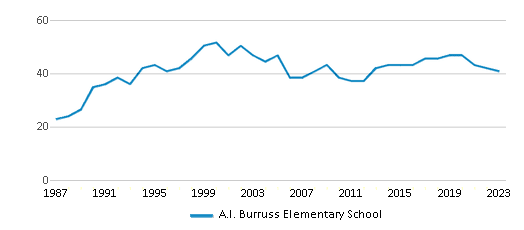
Students by Grade
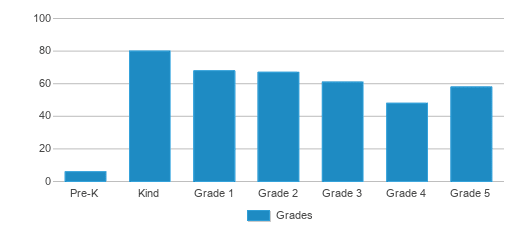
School Calendar
School Rankings
A.l. Burruss Elementary School ranks within the top 50% of all 2,204 schools in Georgia (based off of combined math and reading proficiency testing data).
The diversity score of A.l. Burruss Elementary School is 0.73, which is more than the diversity score at state average of 0.71. The school's diversity has stayed relatively flat over five school years.
Overall Testing Rank
#847 out of 2204 schools
(Top 50%)
(Top 50%)
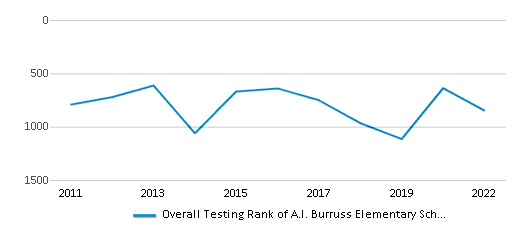
Math Test Scores (% Proficient)
40-44%
37%

Reading/Language Arts Test Scores (% Proficient)
35-39%
40%
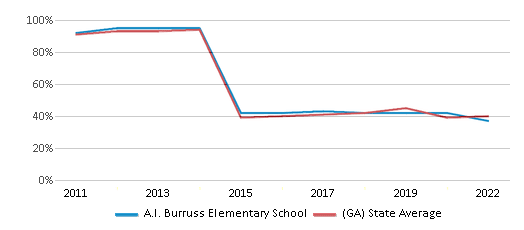
Science Test Scores (% Proficient)
30-34%
40%
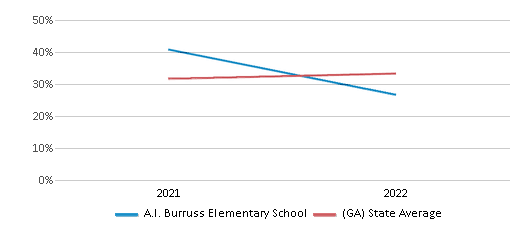
Student : Teacher Ratio
10:1
14:1
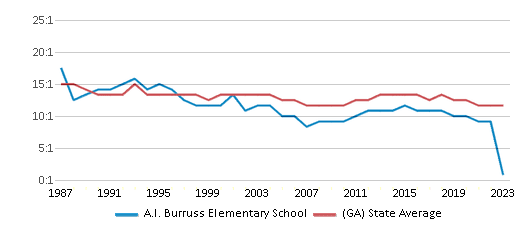
American Indian
n/a
n/a
Asian
2%
5%

Hispanic
24%
19%
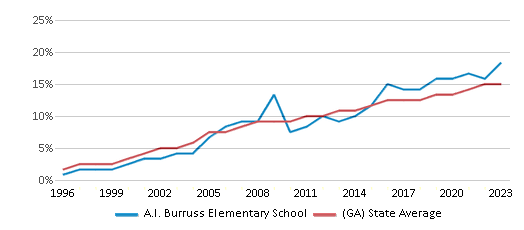
Black
33%
36%
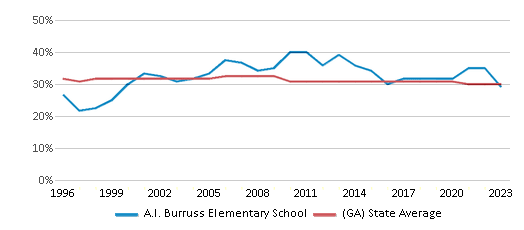
White
33%
35%
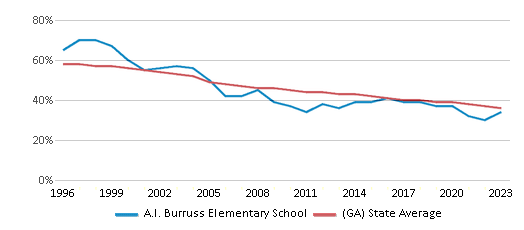
Hawaiian
n/a
n/a
Two or more races
8%
5%
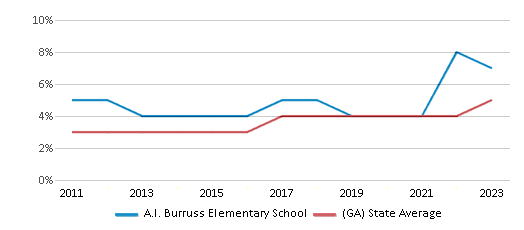
All Ethnic Groups
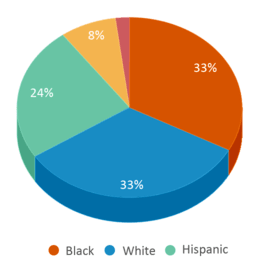
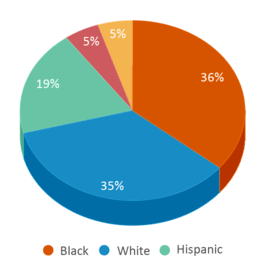
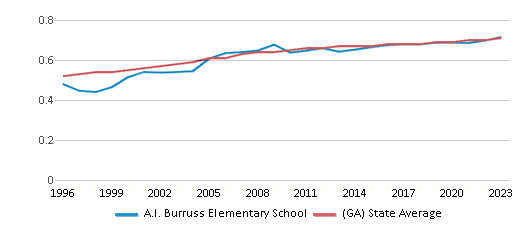
Participates in the National School Lunch Program (NSLP)
Yes
Eligible for Free Lunch
48%
59%
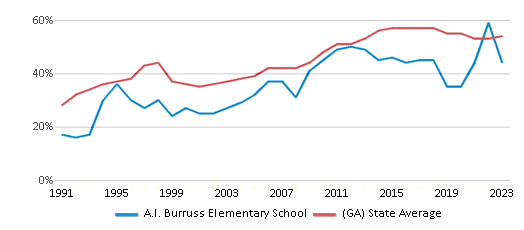
Eligible for Reduced Lunch
6%
5%
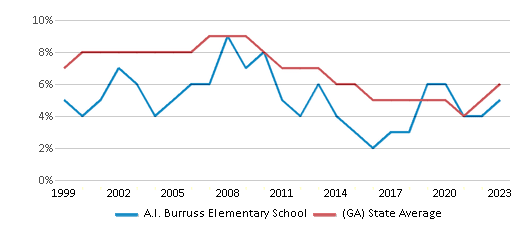
School Statewide Testing
School District Name
Source: National Center for Education Statistics (NCES), GA Dept. of Education
Profile last updated: 02/09/2025
Frequently Asked Questions
What is A.l. Burruss Elementary School's ranking?
A.l. Burruss Elementary School is ranked #847 out of 2,204 schools, which ranks it among the top 50% of public schools in Georgia.
What schools are A.l. Burruss Elementary School often compared to?
A.l. Burruss Elementary Schoolis often viewed alongside schools like West Side Elementary School, Hickory Hills Elementary School by visitors of our site.
What percent of students have achieved state testing proficiency in math and reading?
40-44% of students have achieved math proficiency (compared to the 37% GA state average), while 35-39% of students have achieved reading proficiency (compared to the 40% GA state average).
How many students attend A.l. Burruss Elementary School?
388 students attend A.l. Burruss Elementary School.
What is the racial composition of the student body?
33% of A.l. Burruss Elementary School students are Black, 33% of students are White, 24% of students are Hispanic, 8% of students are Two or more races, and 2% of students are Asian.
What is the student:teacher ratio of A.l. Burruss Elementary School?
A.l. Burruss Elementary School has a student ration of 10:1, which is lower than the Georgia state average of 14:1.
What grades does A.l. Burruss Elementary School offer ?
A.l. Burruss Elementary School offers enrollment in grades Prekindergarten-5
What school district is A.l. Burruss Elementary School part of?
A.l. Burruss Elementary School is part of Marietta City School District.
School Reviews
5 11/19/2013
I had an appointment at Burruss for a tour for my son for next year. We are zoned for Lockheed but found out about the choice program and want to take advantage of a better school choice. I must say the tour was outstanding the principal is so involved and shows so much love and care for the children I was completely sold to make Burruss my first choice for the choice program. I left feeling very comfortable with my son starting kindergarten next year. I would recommend this school to anyone looking for a great elementary school for your child to feel comfortable. Mrs.King is very hands on!!! Excellent school...
Review A.l. Burruss Elementary School. Reviews should be a few sentences in length. Please include any comments on:
- Quality of academic programs, teachers, and facilities
- Availability of music, art, sports and other extracurricular activities
Recent Articles

What Is A Charter School?
Explore the world of charter schools in this comprehensive guide. Learn about their history, how they operate, and the pros and cons of this educational innovation. Discover key facts about charter schools, including admission policies, demographics, and funding, as well as what to look for when considering a charter school for your child.

10 Reasons Why High School Sports Benefit Students
Discover the 10 compelling reasons why high school sports are beneficial for students. This comprehensive article explores how athletics enhance academic performance, foster personal growth, and develop crucial life skills. From improved fitness and time management to leadership development and community representation, learn why participating in high school sports can be a game-changer for students' overall success and well-being.

February 05, 2025
Understanding the U.S. Department of Education: Structure, Impact, and EvolutionWe explore how the Department of Education shapes American education, from its cabinet-level leadership to its impact on millions of students, written for general audiences seeking clarity on this vital institution.





